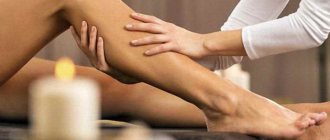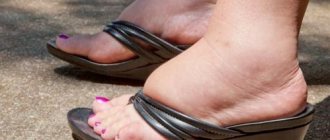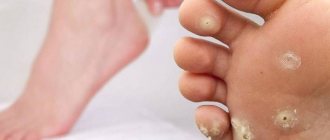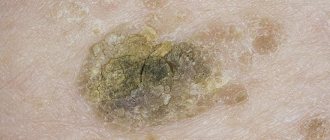Cracked heels are an annoying problem that many people face. Of course, legs with cracks look unattractive. The defect is also uncomfortable and causes pain, which becomes worse when walking. At first these cracks are barely noticeable, but over time they begin to become inflamed. Not everyone knows how to treat cracked heels, but this can be done quite simply with the help of folk remedies.
Causes of crack formation
There are many reasons for the formation of cracked heels. Improper or excessive foot care can provoke this unpleasant disease. Constantly wearing uncomfortable high-heeled shoes can also cause cracks. But in most cases, the defect is one of the symptoms of various diseases. The most common are :
- Obesity, which causes increased stress on the feet.
- Fungal infections of the feet. In addition to cracks, the fungus is accompanied by itching and peeling of the skin between the fingers.
- Diabetes. This disease causes inflammation in the legs.
- Psoriasis. The skin disease is often localized on the soles.
- Iron-deficiency anemia. Iron deficiency in the body can lead to the development of pathological changes in the skin.
- Hypovitaminosis. Insufficient amounts of vitamins E and A in the body.
- Dysfunction of the digestive organs.
- Thyroid diseases.
Quite often, women's heels crack during pregnancy, especially in the last trimester. The reasons for this pathology lie in increased blood sugar levels in pregnant women, as well as insufficiently efficient kidney function and heavy load on the legs.
How to treat heel cracks?
Before you start treating cracked heels, it is worth finding out the presence of diseases that could provoke such a phenomenon. If they are, then simple care, even the most thorough one, will not help solve this issue, and if everything is in order with your health, then it’s worth trying to start by changing your diet and uncomfortable shoes. There are many opinions about this advice from those who visit forums. If there is no effect, you need to contact a beauty salon specialist.
If you turn to professionals, it will be much easier to solve the problem: the cosmetologist will treat the heels and edges of the cracks according to all the rules. This will require at least two sessions, more in more advanced cases. But after visiting the salon, you should not think that the problem is solved forever. Constant independent foot care is required, otherwise even the most effective treatment will not help.
If you are unable or unwilling to go to a beauty salon, you can always try to treat your heels yourself. There are a huge number of folk recipes with which you can quickly get your heels in order. Anyone who wants to learn about the most effective means to solve the problem can visit the forum. It all depends on the condition of the legs and the severity of the problem, but with great desire and perseverance, excellent results can be achieved.
Traditional medicine recipes
A qualified cosmetologist or doctor can help solve problems with your feet. But no less pressing is the question of how to cure cracked heels quickly without the use of pharmaceutical drugs. There are many different folk remedies, the most effective and efficient are given below.
Laundry soap
Despite the fact that laundry soap does not have medicinal properties , it can soften the dead skin layers well and also has a disinfecting effect on the skin.
The simplest method of application is a soap mask at night. Even if there are deep and severe cracks in the heels, treatment with soap will help cope with the problem. To do this, you need to wash your feet well and dry them with a towel, and smear your soles with a piece of 72% laundry soap. After this, put thin socks on your feet and go to bed. In the morning, wash your feet and apply moisturizer. Perform this procedure every day until the cracks completely disappear.
Folk remedies
Treatment with folk remedies
Compresses
Compresses provide a moisturizing and nourishing effect. Before applying the compress, your feet should be washed, wiped and the prepared composition should be applied directly to the cracks and the skin around them. Put plastic bags and woolen socks on top. After the procedure, rinse your feet and apply rich baby cream.
Onion
Onion compress
Onion compress acts as a bactericidal agent. Apply it before bed and leave it until the morning. To prepare the compress, peel two medium-sized onions and grind them to a paste. Steam your feet well in two liters of water with the addition of a spoonful of baking soda. Wipe and apply onion paste. Wrap the top with cling film and secure with a bandage or put on thick cotton socks. In the morning, remove the bandage, wash your feet with soap and rub with a file or pumice stone. Apply cream.
Malolactic Nourishes the skin and heals cracks. Finely chop two medium apples, pour in two hundred ml of milk, add one spoon of baking soda, place on the stove and bring to a boil. Cook for a quarter of an hour. During this time, the apples should boil to a puree. Remove and cool slightly. If the mixture is too runny, add a spoonful of regular flour. Then spread over the heels in a layer of up to one cm, secure with polyethylene and a wide bandage. Hold until the compress begins to cool. Frequency: once every three days.
Potato
Potato compress
The antibacterial and healing effect is guaranteed if you apply the compress ten times in a row daily. Peel two or three potatoes and grate them. Apply immediately to heels and wrap with waterproof material. Leave for two hours. After the procedure, rinse your feet, rub lightly with a pumice stone and apply baby cream.
Made from aloe. Softening and regenerating effect. Before going to bed, make a paste of aloe leaves and apply to washed feet. Secure with plastic, put on warm socks and leave to act until the morning.
Oily
Oil compress
Oil compresses perfectly moisturize and nourish the affected skin on the heels. You can use any oil from the list: regular sunflower, corn and olive, as well as almond and castor. To soften and have an antimicrobial effect, it is allowed to add glycerin - half the volume of the main oil. If you drop a few drops of fir or eucalyptus oil, it will add a wound healing effect and improve blood circulation. So, how to make an oil compress. Steam your legs before the procedure. Heat the oil slightly, dip cotton socks in the oil and put them on your feet. You can put plastic bags on top or wrap them in cling film.
Baths
Baths
If you take foot baths every day, the healing effect is guaranteed.
Herbal Herbal baths have an anti-inflammatory and healing effect. To make a decoction, brew a spoonful of dry herbs with a liter of boiling water and simmer for half an hour over low heat. Remove from heat, pour along with the herb into a container for taking a foot bath and add water to a comfortable temperature. Lower your legs for half an hour. Wipe off and apply cream. Buy a bag of sage, St. John's wort, calendula, elecampane, chamomile, string and oak bark at the pharmacy and alternate herbs for healing baths.
Starchy
Starchy
Starch baths soften and heal affected skin. Adding a few drops of rosemary oil will enhance the effect. For particularly complex cracks, starch can be dissolved in chamomile, St. John's wort or calendula decoctions. Dissolve a spoonful of potato starch in one liter of heated water. Put your feet down for thirty minutes. If the water becomes cool, add a little hot water. After the bath, rinse your feet, apply cream and put on cotton socks. As an addition to treatment after a starch bath, prepare medicinal cakes. Squeeze out equal amounts of aloe and onion juice, add the same amount of fish oil and, adding a little flour, knead the dough like pies. Make small cakes out of it and secure them on your heels with waterproof material and a bandage. Leave until morning. After waking up, remove the pads and wash the cracked heels with the calendula attunement.
With sea salt Restores the skin, softens, exfoliates and improves blood circulation with a bath with the addition of sea salt. Dissolve one hundred grams of sea salt and a spoonful of baking soda in one and a half liters of warm water. The bath time is a quarter of an hour. After the procedure, dry your feet and lubricate with lemon juice. Then apply any vegetable oil and put on woolen socks.
Wine
Wine bath
Baths with dry white wine soften and heal. Pour a spoonful of linden blossom into two hundred ml of wine, put it on the stove and wait until it boils. Pour the wine into a basin, add one liter of warm water and lower your feet. After ten minutes, scrub your heels with a rough washcloth and place them in the bath. Repeat three times, ending with a bath. There is no need to wash your feet, just wipe them and lubricate them with cream or oil.
Ointments
Ointments
You will get a very good effect from using ointments. Apply them before bed and, securing them with plastic or cling film and putting woolen socks on top, leave them until the morning. In the morning, feet should be washed and lightly exfoliated, lubricated with oil or baby cream.
Carrot Ointment made from carrots and pork fat softens and nourishes. Peel and grate one medium carrot. Add the carrot mixture to one hundred grams of melted pork fat and keep in a steam bath for another quarter of an hour. Remove and strain into a glass container. After the ointment has cooled to room temperature, it can be used as described above or after taking foot baths. Store in a cool place.
Herbal
Herbal
For this ointment you will need badger fat. Why badger? Because it contains vitamins A and E, and these vitamins can make the skin firm and elastic. And calendula and celandine, in turn, will not allow the infection to develop. Place fifty ml of badger fat in a steam bath for ten minutes. During this time, pour one spoonful of carefully crushed calendula and celandine into boiling water for one minute. Drain the water and add the herbs to the badger fat. Stirring occasionally, leave to heat for another half hour. Remove and strain the herbs into a glass jar. Before use, heat a small amount of fat-herbal cream over steam and apply to cracks.
Vaseline Vaseline ointments are very easy to prepare. The first one is with plantain. Grind plantain leaves to a powder. Drop 2-3 drops of any vegetable oil into it and mix it with Vaseline, which will require ten times more than the amount of plantain powder. You have obtained a wound-healing and disinfecting ointment.
Calendula ointment is even easier to prepare. Just like with plantain, chop the flowers and combine one spoon of powder with four Vaseline. Calendula ointment has good restorative and anti-inflammatory effects.
Mechanical treatment
The mechanical method includes the following manipulations. The first stage is steaming, the second is peeling, the third is antimicrobial treatment and the fourth is the application of nourishing and moisturizing agents.
Steaming
Steaming
Soap and soda For half an hour, immerse your feet in a solution of one liter of hot water and one spoon of baking soda and a small amount of liquid soap dissolved in it. If the water becomes cool, add a little boiling water.
Glycerin For half an hour, immerse your feet in two liters of water heated to fifty degrees with the addition of a spoonful of glycerin and two tablespoons of table vinegar.
Chamomile
Chamomile steaming
Brew two tablespoons of chamomile in a glass of boiling water and let it brew for ten minutes. Pour the infusion along with chamomile into a bowl of hot water (three liters) and take a foot bath for a quarter of an hour.
Tar To prepare a solution for this bath, you need to grate half a piece of tar soap and dissolve it in three liters of hot water. If you don't like the smell, add three to five drops of any citrus oil to the water. Immerse your feet in the bath for twenty minutes.
Peeling
Peeling
You can remove dead skin layers on your heels once a week, not more often! For peeling, you can use a pumice stone or a special pedicure grater. Corn flour, sea salt and natural ground coffee work very well as a scrub. Making it yourself is not difficult. Just take two spoons of any ingredient and mix with a small amount of liquid soap. Then rub the scrub into your heels for five minutes. After the procedure, rinse your feet with water and dry. Treat the cracks with hydrogen peroxide and lubricate with a special cream.
Prevention
Prevention
If you are a bathhouse lover or regularly visit a swimming pool or gym, buy yourself special shoes - closed rubber shoes. They will protect your feet from the penetration of microorganisms that cause skin diseases, incl. fungus. Don't forget to apply antifungal medications to your feet. Wear fresh hosiery every day. It is better if they are made from natural fibers. Outdoor shoes should fit you well, not cause inconvenience when walking, and must be selected according to the season, preferably made from natural materials. Absolutely refuse to wear someone else's shoes. Even if you go on a visit, take your own replacement shoes with you. Each member of your family should have their own pedicure tools. Throw away a rug made of porous material from the bathroom - bacteria love to live and multiply in it. It is important to follow a diet. You should receive a sufficient amount of vitamins and microelements with food that help the skin recover. Do not forget about the drinking regime - you should drink up to two liters of clean water per day.
Reviews about the fight against rough heels
Every summer I get deep cracks in my heels that have never been able to heal. The heels could become so cracked that they began to bleed. I tried different creams and ointments for treatment, but there was no effect. But this year I decided to try traditional medicine recipes for myself. I prepared an oil solution, which I rubbed on my heels, wrapped them in plastic wrap on top and put on my socks. A similar procedure was carried out every day before bed. After about 10 days, the cracks completely disappeared and the skin became soft.
Lydia, 62 years old
Regular boiled potatoes helped me cope with dry skin on my legs. I just made mashed potato compresses at night. The cracks have completely disappeared. But after that, I began to carefully care for the skin of my heels, regularly do peelings, and use moisturizers.
Inga, 34 years old
As soon as I start wearing flip-flops in the summer, cracks immediately appear on the heels. For treatment I always bought Uroderm cream. And if someone still doesn’t know how to cure heels, I recommend this drug.
Alexandra, 37 years old
Originally posted 2018-03-28 08:55:15.
Main causes of heel pain
The main causes of heel pain are associated with joint pathologies and the presence of heel spurs. Occasionally, injuries, fractures, cracks, and fungi can be observed. Pain often appears when a callus appears. But with a change of shoes and proper treatment, it is possible to quickly eliminate signs of pathology.
Among the most common factors that cause pain syndrome in the limb, there is a disease called heel spur - a spur is considered a disease that manifests itself as the growth of bone tissue in the area of the plantar planes of the bone on the heel (osteophytes).
A spur is a thorn that causes compression of the soft tissues of the foot and leads to pain in the heels when walking. The disease is caused by pressure on the heels and toes of uncomfortable shoes. There is an accumulation of salts and a spur protrudes into the heel, so the person feels pain when he steps on the foot.
There is a group of factors that are interconnected with pain manifestations of the heel bone and its surrounding ligaments and fascia. Fasciitis factors are associated with the appearance of inflammation of the heels and stretching of the fascia.
There are factors of fasciitis such as:
- Extra pounds - due to excess weight, pressure on the soles increases, which causes pain in the feet when walking.
- Sports activities - sometimes pain appears after running or other exercises that involve heavy loads. Also, due to stress, a pathological phenomenon or tendon rupture may develop.
- Diabetes
- Flat feet
- Constantly walking in stiletto heels
Fasciitis can cause pain in the foot, developing due to tight shoes and standing for a long time. As a result, a growth forms on them, which puts pressure on the tissue and leads to discomfort, clearly felt after waking up.
Acute discomfort in the sole occurs due to traumatic injuries, bruises, sprains and other types of damage.
In this situation, immediate consultation with a doctor is required to avoid more serious negative manifestations.
Chronic pathologies of joints and bones often lead to the formation of a sign of pain when it is possible to step on the heel area while walking. Often, arthritis, arthrosis, in addition to the breakdown of the joint, leads to the accumulation of salts that are difficult to treat.
Rheumatoid arthritis is a factor in the breakdown of a group of joints, due to which the sign of heel pain is accompanied by other symptoms.
Heel pain also develops due to infectious pathologies (chlamydia). The pathology is manifested by constant pain discomfort, which intensifies in the evening. The presence of malignant tumors on the soles leads to compression of blood vessels and nerve fibers, which leads to chronic pain.
In addition to pain, the feet can smell unpleasant, change skin color, and crack. Thus, a fungus appears, which can appear after visiting a bathhouse or walking barefoot. Often, a fungal infection affects the fingers and nails, gradually moving to the heels.
The occurrence of fungus is also observed with weak immunity and related diseases.
The presence of cracks and pain in the heel, in addition to thorns and pathological processes in the joints, appear due to bruises, sprains, prolonged walking in uncomfortable shoes, and endless pressure on the feet.
Treatment of heels with hydrogen peroxide
An excellent remedy for treating cracked heels is hydrogen peroxide. It acts on the skin of your feet like boiling water in ten minutes, steaming it as if you had spent an hour in a hot bath. The tool is used like this:
- Four liters of warm water are poured into a basin and four tablespoons of hydrogen peroxide are added;
- The legs are immersed in the basin so that the feet are completely in the water;
- After ten or fifteen minutes, we remove our legs from the pelvis and walk over problem areas with pumice;
- Rinse your feet, dry with a towel and apply a rich cream to the skin.
If you carry out this procedure at least once a week, your heels will always remain smooth and beautiful.
Masks for cracked heels
What else you can do when your heels crack is to use a folk remedy such as a mask. Its advantage is that the mask is applied to the skin for a short time. You don't have to walk around all night or half the day with uncomfortable bandages on your feet.
Apply the mask to the steamed skin of the heels and leave for 15-20 minutes. After the mask, apply moisturizer.
You can make the same mask, and you can alternate - as you like. Here are some healthy recipes.
- Place the fleshy aloe leaf in the refrigerator for a few days and then grind it. Mix a tablespoon of the resulting pulp with egg white.
- Boil oatmeal in water and add more flaxseed or any other vegetable oil to it. Wait for the porridge to cool slightly and place the mixture in plastic bags. Put them on your feet and wait two hours.
- Mix equal amounts of honey, full-fat cottage cheese and sour cream.
- Combine 30 g of softened butter with half a glass of yogurt. Stir until smooth. This mask stays on your feet for 40 minutes.
- Boil prunes in milk and chop them. Apply the paste to your heels and hold until it cools down.
- Grate a fresh apple. Apply the resulting mass to the cleaned
- Combine 3 tbsp. l. glycerin with 1 tbsp. l. apple cider vinegar. Apply to heels and secure with film. Put socks on top. Wash off after an hour.
- Lubricate your feet with any vegetable oil and wrap with film on top. After 1-2 hours, remove the mask.
Home recipes for treating cracks
With the help of homemade remedies, you can forget about this problem forever.
Glycerin with vinegar
Many women have already used one magical remedy for cracks with glycerin and vinegar. His recipe is so simple that it won’t take much time.
Buy a bottle of glycerin at the pharmacy and fill it with vinegar essence up to the very neck. Shake, wet your heels with this mixture, wrap in a plastic bag, put on your socks and go to bed!
You will only need 3-4 treatments to get soft, smooth feet. This product is quickly absorbed into the epidermis, so 2-3 sessions can be performed per day.
Herbal recipe
make a decoction of chamomile and calendula. Take 1 tbsp. spoon of each herb, steam with 2 cups of boiling water, let stand for 30 minutes.
Pour the broth into a basin, add warm water to cover your feet to the ankles. Steam the skin of your feet and dry with a towel. Then, put fresh woodlice in your socks and put them on your feet. Wear socks all day.
You can make baths daily either from a mixture of herbs, or from any of the above-mentioned herbs, the effect will be noticeable in 2-3 weeks.











